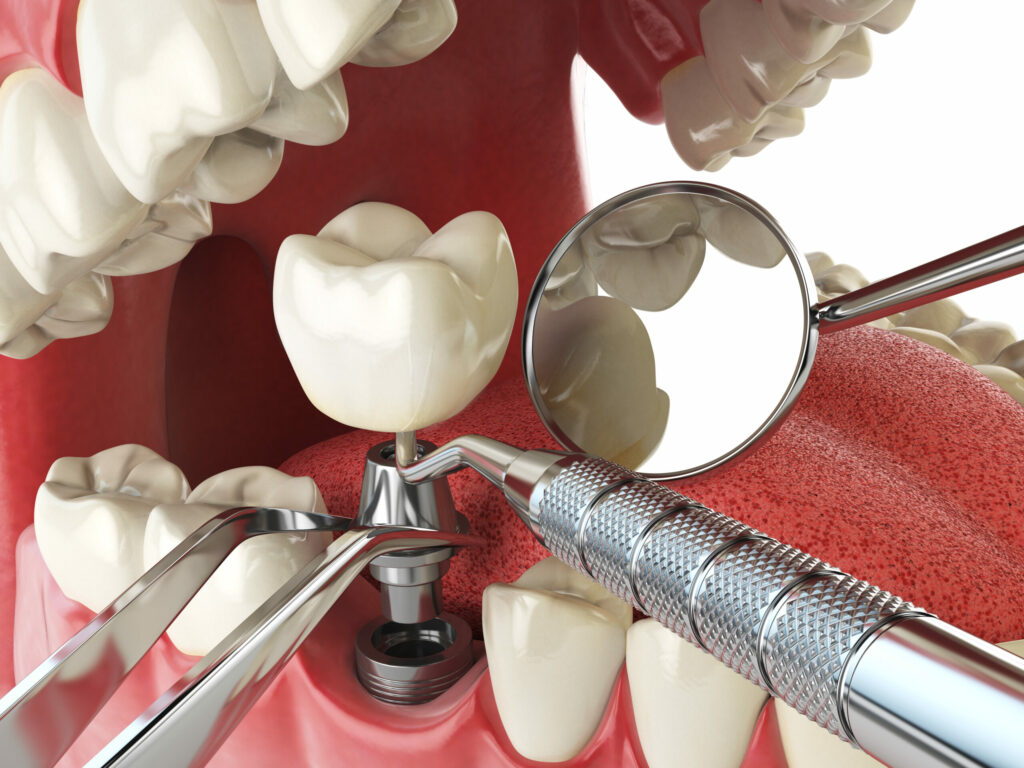Missing one or more teeth due to injury, age, or a medical condition is quite common, and living with missing teeth can be a struggle. It not only hinders a person\’s ability to eat, drink, and speak normally, but it can also alter a person\’s physical appearance, lead to the deterioration of the jawbone, and have a negative effect on self-esteem.
Thankfully, modern cosmetic and restorative dentistry offers a variety of treatment options, such as dentures, dental bridges, and dental implants, that are designed to replace our patients\’ missing teeth and restore the look, feel, and function of their smiles.
Due to their versatility, natural look, and natural feel, dental implants are by far one of the most popular tooth replacement options available.
What Are Dental Implants?
A dental implant is a permanent tooth replacement option. A dental implant is comprised of three parts:
Implant Body – This metal screw-like dental device is surgically placed in a patient\’s jawbone to act as a permanent anchor.
Abutment – An abutment extends the post and affixes to the artificial tooth.
Artificial Tooth – The artificial tooth is a dental crown or cap (designed to resemble and mimic the original tooth). It is permanently affixed to cover the top of the abutment and replace the missing tooth.
Since they are anchored in the jawbone, dental implants look, feel, and work just like natural teeth. They also provide stimulation and support to the jawbone, which prevents the type of bone deterioration and associated dental problems that people who are missing teeth are at risk of developing.
Additionally, for patients missing more than one tooth, dental implants can also act as anchors for fixed bridges and permanently fixed dentures called all-on-4 dentures.
What Is Dental Implant Surgery?
Due to their permanent nature and anchored design, dental implants require one or more surgical procedures to be placed in a patient\’s jawbone. This procedure replaces the patient\’s natural tooth roots with a metal, screw-like post.
What to Expect From Dental Implant Surgery
The process of dental implant surgery varies based on each patient\’s medical history, dental health, bone density, and condition of the jawbone. Some patients can have a dental implant anchor placed in a single surgical procedure. Other patients who do not have enough existing jawbone to support a dental implant\’s post will require multiple procedures for bone grafting before the implant can be placed.
Placing the implant body requires a surgical procedure that\’s followed by a period of healing. During this period, which can take several months, the patient\’s jawbone will undergo a process called osseointegration as the jawbone fuses to the dental implant. This is accomplished by bone actually growing into the threads of the implant body’s screw-like shape, locking it in place.
Once a dental implant\’s post has fully healed and fused to the jawbone, the abutment and artificial tooth can then be placed by the restoring dentist.
Dental Implant Surgery Steps
- Removal of the damaged tooth and roots
- If necessary, periodontal disease treatment and management
- If necessary, jawbone preparation (bone grafting)
- Placement of dental implant
- Osseointegration and healing
- Placement of abutment
- Placement of the artificial tooth (crown or cap)
Who Performs Dental Implant Surgery?
A variety of dental care providers are qualified and experienced in providing dental implant surgery including:
- General dentists
- Periodontists
- Oral Surgeons
Selecting the type of dental care provider to perform your dental implant surgery is a highly personal choice that depends on your comfort level with the dental care provider and the extent of surgery you will need for successful dental implant placement.
While specialists like Periodontists and Oral Surgeons are trained from day one in implant placement, general dentists are not. Specialists undergo rigorous training in implant types, surgery techniques, site preparation, anesthesia, and management of medical conditions and complications. General dentists can learn all of the same information as an additional service provided to their patients.
If you need a dental implant with or without bone grafting, it\’s best to talk with your dentist about their history and experience with performing oral surgeries before you decide on the type of dental care provider you wish to have perform your surgery. At Smile Hilliard, the doctors work closely with the best specialists in the area to develop an implant plan unique to you!
In Need of a Dental Implant? Schedule a Consultation at Smile Hilliard
At Smile Hilliard, we\’re pleased to provide our patients with a comprehensive list of restorative dentistry services, including dental implants.
If you\’re missing one or more teeth and are interested in restoring your smile with a tooth replacement option that looks and feels like a natural tooth, then we welcome you to schedule a smile restoration appointment with one of our dentists at Smile Hilliard in Hilliard, OH.
We\’ll talk with you about your smile goals, examine your teeth and gums, and evaluate your jawbone to help you determine the best course of treatment designed to meet your unique dental care needs. We\’ll work with you to restore the function, feel, and look of your teeth while helping you get the smile of your dreams.






